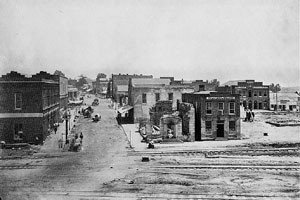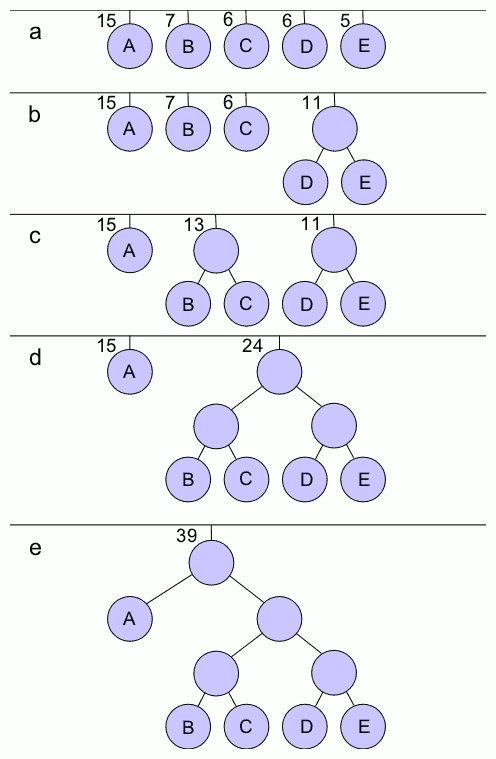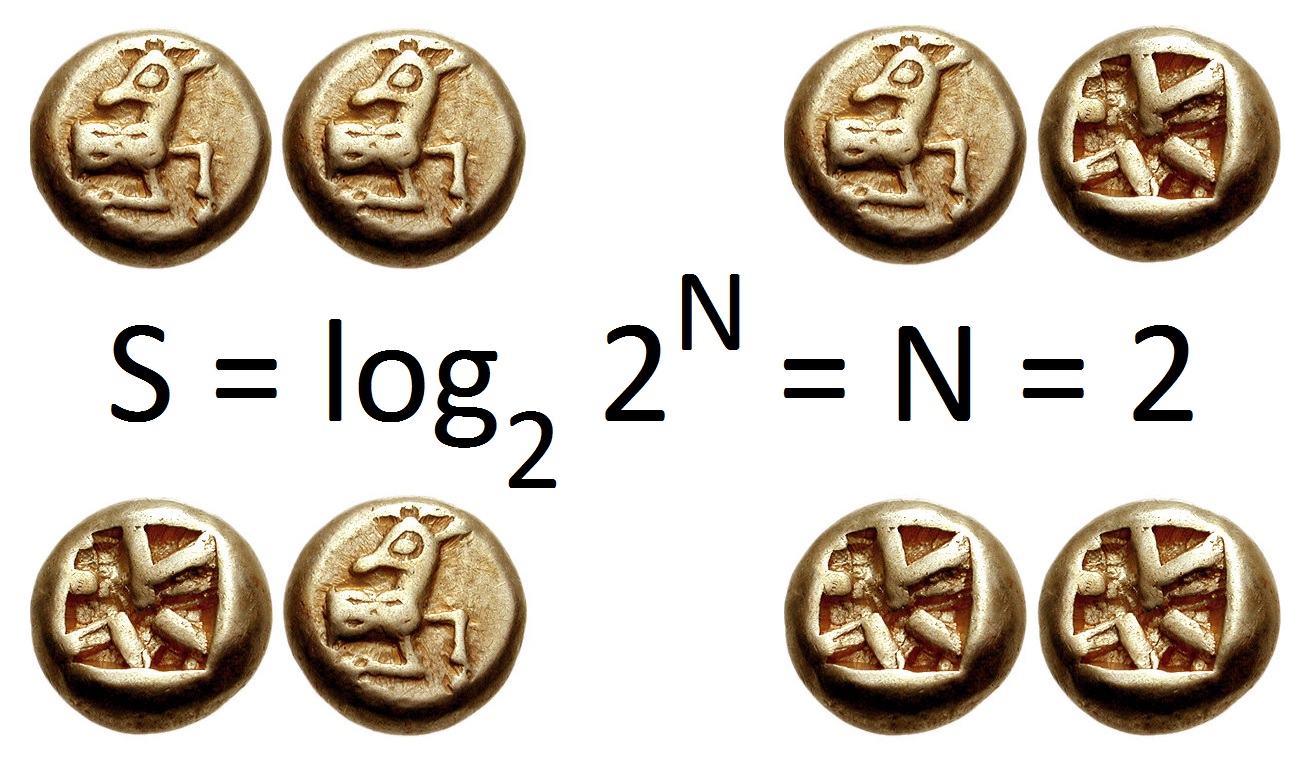|
Tunstall Coding
In computer science and information theory, Tunstall coding is a form of entropy coding used for lossless data compression. History Tunstall coding was the subject of Brian Parker Tunstall's PhD thesis in 1967, while at Georgia Institute of Technology. The subject of that thesis was "Synthesis of noiseless compression codes" Its design is a precursor to Lempel–Ziv. Properties Unlike variable-length codes, which include Huffman and Lempel–Ziv coding, Tunstall coding is a code which maps source symbols to a fixed number of bits. Both Tunstall codes and Lempel–Ziv codes represent variable-length words by fixed-length codes. Unlike typical set encoding, Tunstall coding parses a stochastic source with codewords of variable length. It can be shown Study of Tunstall's algorithm from [...More Info...] [...Related Items...] OR: [Wikipedia] [Google] [Baidu] |
Computer Science
Computer science is the study of computation, automation, and information. Computer science spans theoretical disciplines (such as algorithms, theory of computation, information theory, and automation) to practical disciplines (including the design and implementation of hardware and software). Computer science is generally considered an area of academic research and distinct from computer programming. Algorithms and data structures are central to computer science. The theory of computation concerns abstract models of computation and general classes of problems that can be solved using them. The fields of cryptography and computer security involve studying the means for secure communication and for preventing security vulnerabilities. Computer graphics and computational geometry address the generation of images. Programming language theory considers different ways to describe computational processes, and database theory concerns the management of repositories ... [...More Info...] [...Related Items...] OR: [Wikipedia] [Google] [Baidu] |
Information Theory
Information theory is the scientific study of the quantification, storage, and communication of information. The field was originally established by the works of Harry Nyquist and Ralph Hartley, in the 1920s, and Claude Shannon in the 1940s. The field is at the intersection of probability theory, statistics, computer science, statistical mechanics, information engineering, and electrical engineering. A key measure in information theory is entropy. Entropy quantifies the amount of uncertainty involved in the value of a random variable or the outcome of a random process. For example, identifying the outcome of a fair coin flip (with two equally likely outcomes) provides less information (lower entropy) than specifying the outcome from a roll of a die (with six equally likely outcomes). Some other important measures in information theory are mutual information, channel capacity, error exponents, and relative entropy. Important sub-fields of information theory include s ... [...More Info...] [...Related Items...] OR: [Wikipedia] [Google] [Baidu] |
Entropy Coding
In information theory, an entropy coding (or entropy encoding) is any lossless data compression method that attempts to approach the lower bound declared by Shannon's source coding theorem, which states that any lossless data compression method must have expected code length greater or equal to the entropy of the source. More precisely, the source coding theorem states that for any source distribution, the expected code length satisfies \mathbb E_(d(x))\geq \mathbb E_ \log_b(P(x))/math>, where l is the number of symbols in a code word, d is the coding function, b is the number of symbols used to make output codes and P is the probability of the source symbol. An entropy coding attempts to approach this lower bound. Two of the most common entropy coding techniques are Huffman coding and arithmetic coding. If the approximate entropy characteristics of a data stream are known in advance (especially for signal compression), a simpler static code may be useful. These static codes ... [...More Info...] [...Related Items...] OR: [Wikipedia] [Google] [Baidu] |
Lossless Data Compression
Lossless compression is a class of data compression that allows the original data to be perfectly reconstructed from the compressed data with no loss of information. Lossless compression is possible because most real-world data exhibits statistical redundancy. By contrast, lossy compression permits reconstruction only of an approximation of the original data, though usually with greatly improved compression rates (and therefore reduced media sizes). By operation of the pigeonhole principle, no lossless compression algorithm can efficiently compress all possible data. For this reason, many different algorithms exist that are designed either with a specific type of input data in mind or with specific assumptions about what kinds of redundancy the uncompressed data are likely to contain. Therefore, compression ratios tend to be stronger on human- and machine-readable documents and code in comparison to entropic binary data (random bytes). Lossless data compression is used in ... [...More Info...] [...Related Items...] OR: [Wikipedia] [Google] [Baidu] |
Georgia Institute Of Technology
The Georgia Institute of Technology, commonly referred to as Georgia Tech or, in the state of Georgia, as Tech or The Institute, is a public research university and institute of technology in Atlanta, Georgia. Established in 1885, it is part of the University System of Georgia and has satellite campuses in Savannah, Georgia; Metz, France; Shenzhen, China; and Singapore. The school was founded as the Georgia School of Technology as part of Reconstruction plans to build an industrial economy in the post-Civil War Southern United States. Initially, it offered only a degree in mechanical engineering. By 1901, its curriculum had expanded to include electrical, civil, and chemical engineering. In 1948, the school changed its name to reflect its evolution from a trade school to a larger and more capable technical institute and research university. Today, Georgia Tech is organized into six colleges and contains about 31 departments/units, with emphasis on science and technolog ... [...More Info...] [...Related Items...] OR: [Wikipedia] [Google] [Baidu] |
Lempel–Ziv
LZ77 and LZ78 are the two lossless data compression algorithms published in papers by Abraham Lempel and Jacob Ziv in 1977 and 1978. They are also known as LZ1 and LZ2 respectively. These two algorithms form the basis for many variations including LZW, LZSS, LZMA and others. Besides their academic influence, these algorithms formed the basis of several ubiquitous compression schemes, including GIF and the DEFLATE algorithm used in PNG and ZIP. They are both theoretically dictionary coders. LZ77 maintains a sliding window during compression. This was later shown to be equivalent to the ''explicit dictionary'' constructed by LZ78—however, they are only equivalent when the entire data is intended to be decompressed. Since LZ77 encodes and decodes from a sliding window over previously seen characters, decompression must always start at the beginning of the input. Conceptually, LZ78 decompression could allow random access to the input if the entire dictionary were known in adva ... [...More Info...] [...Related Items...] OR: [Wikipedia] [Google] [Baidu] |
Variable-length Code
In coding theory a variable-length code is a code which maps source symbols to a ''variable'' number of bits. Variable-length codes can allow sources to be compressed and decompressed with ''zero'' error (lossless data compression) and still be read back symbol by symbol. With the right coding strategy an independent and identically-distributed source may be compressed almost arbitrarily close to its entropy. This is in contrast to fixed length coding methods, for which data compression is only possible for large blocks of data, and any compression beyond the logarithm of the total number of possibilities comes with a finite (though perhaps arbitrarily small) probability of failure. Some examples of well-known variable-length coding strategies are Huffman coding, Lempel–Ziv coding, arithmetic coding, and context-adaptive variable-length coding. Codes and their extensions The extension of a code is the mapping of finite length source sequences to finite length bit stri ... [...More Info...] [...Related Items...] OR: [Wikipedia] [Google] [Baidu] |
Huffman Coding
In computer science and information theory, a Huffman code is a particular type of optimal prefix code that is commonly used for lossless data compression. The process of finding or using such a code proceeds by means of Huffman coding, an algorithm developed by David A. Huffman while he was a Sc.D. student at MIT, and published in the 1952 paper "A Method for the Construction of Minimum-Redundancy Codes". The output from Huffman's algorithm can be viewed as a variable-length code table for encoding a source symbol (such as a character in a file). The algorithm derives this table from the estimated probability or frequency of occurrence (''weight'') for each possible value of the source symbol. As in other entropy encoding methods, more common symbols are generally represented using fewer bits than less common symbols. Huffman's method can be efficiently implemented, finding a code in time linear to the number of input weights if these weights are sorted. However, althou ... [...More Info...] [...Related Items...] OR: [Wikipedia] [Google] [Baidu] |
Code
In communications and information processing, code is a system of rules to convert information—such as a letter, word, sound, image, or gesture—into another form, sometimes shortened or secret, for communication through a communication channel or storage in a storage medium. An early example is an invention of language, which enabled a person, through speech, to communicate what they thought, saw, heard, or felt to others. But speech limits the range of communication to the distance a voice can carry and limits the audience to those present when the speech is uttered. The invention of writing, which converted spoken language into visual symbols, extended the range of communication across space and time. The process of encoding converts information from a source into symbols for communication or storage. Decoding is the reverse process, converting code symbols back into a form that the recipient understands, such as English or/and Spanish. One reason for coding ... [...More Info...] [...Related Items...] OR: [Wikipedia] [Google] [Baidu] |
Typical Set
In information theory, the typical set is a set of sequences whose probability is close to two raised to the negative power of the entropy of their source distribution. That this set has total probability close to one is a consequence of the asymptotic equipartition property (AEP) which is a kind of law of large numbers. The notion of typicality is only concerned with the probability of a sequence and not the actual sequence itself. This has great use in compression theory as it provides a theoretical means for compressing data, allowing us to represent any sequence ''X''''n'' using ''nH''(''X'') bits on average, and, hence, justifying the use of entropy as a measure of information from a source. The AEP can also be proven for a large class of stationary ergodic processes, allowing typical set to be defined in more general cases. (Weakly) typical sequences (weak typicality, entropy typicality) If a sequence ''x''1, ..., ''x''''n'' is drawn from an i.i.d. distribution ' ... [...More Info...] [...Related Items...] OR: [Wikipedia] [Google] [Baidu] |
Entropy (information Theory)
In information theory, the entropy of a random variable is the average level of "information", "surprise", or "uncertainty" inherent to the variable's possible outcomes. Given a discrete random variable X, which takes values in the alphabet \mathcal and is distributed according to p: \mathcal\to , 1/math>: \Eta(X) := -\sum_ p(x) \log p(x) = \mathbb \log p(X), where \Sigma denotes the sum over the variable's possible values. The choice of base for \log, the logarithm, varies for different applications. Base 2 gives the unit of bits (or " shannons"), while base ''e'' gives "natural units" nat, and base 10 gives units of "dits", "bans", or " hartleys". An equivalent definition of entropy is the expected value of the self-information of a variable. The concept of information entropy was introduced by Claude Shannon in his 1948 paper "A Mathematical Theory of Communication",PDF archived froherePDF archived frohere and is also referred to as Shannon entropy. Shannon's theory def ... [...More Info...] [...Related Items...] OR: [Wikipedia] [Google] [Baidu] |




